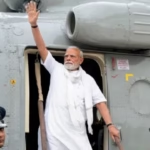India’s Assertive Energy Diplomacy – Setting the Record Straight
A Clash of Narratives on the Global Stage
On August 2, 2025, a diplomatic ripple surged across international headlines. Former U.S. President Donald Trump, during a campaign rally in Ohio, accused India of buying “massive amounts of Russian oil,” implying that New Delhi’s energy purchases were indirectly funding Moscow’s military ambitions. His remarks were sharp, populist, and politically loaded, characteristic of the election trail. But they were also factually tenuous and diplomatically insensitive—especially toward a long-time strategic partner like India.
India wasted no time in issuing a formal rebuttal. The Ministry of External Affairs (MEA), in a statement later that day, called Trump’s claim “misinformed” and emphasized that India’s energy policy is driven by its national interest, not dictated by global narratives or third-party expectations.
This episode did more than just refute a claim—it underscored the shifting dynamics of global energy politics, the growing assertiveness of Indian foreign policy, and the enduring complexity of U.S.-India relations.
Historical Context: India’s Evolution in Energy Strategy
India’s reliance on oil imports is not a new story. With limited domestic reserves and a rapidly expanding economy, it has always had to walk a tightrope in securing stable, affordable energy sources. For decades, this meant cultivating diverse partnerships—from the Gulf to Latin America, from Iran to Russia.
The 2022 Ukraine crisis added a new layer of geopolitical risk. As the West imposed sweeping sanctions on Russia, many global energy supply chains were disrupted. But India, like China and several other countries in the Global South, saw an opportunity amidst the chaos: access to discounted Russian crude.
While Western nations sought to punish Moscow, India prioritized its energy security. Its move wasn’t ideological but pragmatic. Domestic inflation was rising, fuel prices were hurting the common citizen, and ensuring uninterrupted supplies became paramount.
What critics like Trump fail to understand—or deliberately ignore—is that India’s Russian oil imports have always been transparent, legal, and negotiated in accordance with international law, often routed through third-party traders and settled in non-dollar currencies.
Diplomatic Response: Firm, Measured, and Clear
The MEA’s statement on August 2 was a masterclass in modern diplomacy: calm, firm, and policy-driven. It stated unequivocally that “India has always followed a balanced approach guided by national interest,” and that “energy procurement is a sovereign decision based on availability, price, and reliability.”
Unlike political grandstanding, India’s tone was devoid of reactionary rhetoric. There was no personal targeting of Trump. Instead, the focus remained on policy principles. This approach aligns with India’s recent trend of strategic autonomy—a doctrine that refuses to be boxed into ideological camps or geopolitical binaries.
Moreover, the rebuttal subtly reminded the world of India’s role as a responsible global player. Not only does India maintain diversified energy sources, but it has also increased its renewable capacity, expanded storage infrastructure, and supported climate commitments through the International Solar Alliance and G20 initiatives.
India’s Global Image: Not a Passive Player Anymore
Gone are the days when India would quietly absorb international criticism without pushback. From defending its trade policies at the WTO to abstaining on United Nations resolutions that conflict with national priorities, India is now assertive without being aggressive, pragmatic without being passive.
This new posture is a reflection of India’s rising global clout—both economically and diplomatically. With a population of over 1.4 billion, a GDP crossing $4 trillion, and growing influence in global forums like the G20, BRICS, and SCO, New Delhi is no longer a silent spectator in global affairs.
It is worth noting that the United States itself continues to engage with India at the highest levels—be it through strategic dialogues, defense cooperation, or technology partnerships. This makes Trump’s remarks even more politically curious, given that they risk alienating an essential Indo-Pacific partner.
India, Oil, and the Optics of Sovereignty
The August 2 incident was not just a rebuttal of a former U.S. President’s campaign comment. It was a reaffirmation of India’s sovereign voice on the world stage. In a multipolar world, where energy security is intertwined with diplomacy, climate goals, and national pride, India is no longer willing to be lectured on choices that affect its 1.4 billion citizens.
As the story unfolds in the coming weeks—with international reactions, domestic political debates, and likely further commentary from Trump’s camp—one thing is clear: New Delhi has drawn its line in the sand. And that line is called national interest.
Decoding the Trump Doctrine on Oil: Politics, Perception, and the 2024 Legacy
We will explore the deeper political motivations behind Trump’s remarks, the energy dynamics between the U.S. and Russia, and how India fits into this broader matrix.
When Donald Trump took the stage in Ohio on August 1, 2025, his remarks about India’s alleged “massive oil purchases” from Russia were not an isolated outburst. They were part of a larger campaign strategy—rooted in populist energy nationalism, a transactional view of global diplomacy, and a relentless focus on projecting strength to his base. But in making these statements, Trump didn’t just reignite controversy; he also exposed a fundamental misunderstanding—or misrepresentation—of the nuanced web that is global oil diplomacy.
To understand why Trump said what he did, one must step back into the political, economic, and ideological framework that shaped the Trump Doctrine during his presidency and continues to define his rhetoric even today.
The Trump Doctrine: America First, Multilateralism Last
Trump’s foreign policy has always been characterized by three traits: unapologetic nationalism, strategic unpredictability, and a zero-sum view of alliances. Under his administration from 2017 to 2021, the U.S. withdrew from multiple global agreements—the Paris Climate Accord, the Iran Nuclear Deal, the Trans-Pacific Partnership—based on the belief that global commitments were undermining American sovereignty.
In the energy sector, Trump’s “America First” policy pushed for U.S. energy dominance, celebrating record shale oil production and aggressively promoting American liquefied natural gas (LNG) exports. His administration rolled back environmental regulations and actively discouraged reliance on OPEC or other foreign sources.
This mindset didn’t just shape domestic policy—it shaped how Trump viewed the energy strategies of other nations. Any country that chose to diversify away from the U.S. or engage with U.S. adversaries, like Russia or Iran, was viewed as suspect or ungrateful, even if those moves were based on legitimate national interest.
Thus, Trump’s comment on India was not just about oil—it was a rebuke of independence in foreign policy, a reminder of his expectation that allies act in alignment with American priorities, not their own.
Political Optics: India as Collateral in U.S. Domestic Discourse
In a U.S. election year, foreign policy narratives often become political tools. Trump’s mention of India wasn’t targeted at India per se—it was designed to signal toughness to his domestic audience. With energy prices being a recurring political flashpoint and inflation worrying middle-class voters, Trump has been eager to pin blame on foreign governments, global institutions, and weak leadership abroad.
India, in this scenario, became a convenient scapegoat, portrayed as a major economy taking advantage of cheap Russian oil while Americans “suffer at the pump.” It mirrors a broader theme that defined Trump’s first campaign in 2016—blaming global partners for undercutting the U.S. economy.
But what such political framing ignores is the strategic partnership between India and the U.S.—a relationship built on decades of trust, shared democratic values, defense ties, and economic interdependence. To reduce India’s sovereign energy decisions to a campaign punchline is, at best, politically expedient. At worst, it is diplomatically short-sighted.
The Global Oil Chessboard: What the Numbers Actually Say
Let’s look at the facts. As of mid-2025, India continues to import oil from multiple sources: the Middle East, the United States, Africa, Latin America, and Russia. While imports from Russia spiked in 2022 and 2023 due to heavily discounted rates, by 2024-25, the percentage share of Russian crude in India’s overall import basket had already begun to decline, as market conditions stabilized and new supply chains opened.
Additionally:
- India purchases Russian oil through legally compliant channels, often via intermediaries and private traders.
- Most of these trades are settled in non-dollar currencies, including rupees, yuan, and UAE dirhams—thus bypassing any direct violation of U.S. secondary sanctions.
- India has consistently been transparent in its dealings, reporting energy imports through public channels and engaging in multilateral forums.
More importantly, India has not committed to any long-term dependence on Russian energy. In fact, it continues to strengthen ties with the United States on clean energy, LNG imports, technology transfers, and climate finance initiatives.
So while the optics of “India funding Russia” may serve a campaign narrative, the data tells a far more balanced story—one of diversification, legal compliance, and pragmatic diplomacy.
India’s Strategic Autonomy: The Foundation of Its Global Standing
India’s energy diplomacy cannot be understood in isolation. It is an extension of its broader doctrine of strategic autonomy, which has guided its actions in multiple domains—from defense procurement and trade alliances to conflict mediation and vaccine diplomacy.
This doctrine has found consistent expression under Prime Minister Narendra Modi’s leadership, particularly during the Russia-Ukraine conflict. Even as India maintained strong ties with the U.S. and Europe, it refused to succumb to pressure on oil imports or UN votes. Instead, it positioned itself as a balancer—engaging all parties while protecting national interests.
India’s external affairs minister, Dr. S. Jaishankar, has articulated this principle clearly in global forums. “We are not sitting on the fence,” he said in 2022. “We are sitting on our ground.” That ground is defined by geography, development needs, domestic politics, and a deep understanding of global realpolitik.
In that context, Trump’s statement—however loud—does little to shake India’s resolve. If anything, it further validates New Delhi’s decision to chart its own course.
Beyond the Noise, Toward Strategic Clarity
Trump’s rhetoric might stir headlines, but it doesn’t change facts. India is not funding Russia’s war. It is fueling its own economy in the most responsible, law-abiding way possible under volatile global conditions. The former U.S. President’s comments may appeal to sections of his political base, but they do little to alter the reality of a world where power is no longer unipolar and sovereignty cannot be dictated.
As India responds not just diplomatically but strategically—by continuing to engage with allies, fortify its economic resilience, and diversify its energy mix—it sends a clear message: respect for sovereignty is the cornerstone of true partnership.
The relationship between India and the United States has evolved into one of the most significant bilateral partnerships of the 21st century. While traditionally rooted in shared democratic values and people-to-people ties, it has expanded over time into a broad strategic collaboration—encompassing defense, technology, counterterrorism, space, and increasingly, energy security.
Yet, even the strongest alliances experience moments of divergence. The current tension over Russian oil imports—sparked by former President Trump’s allegations—sheds light on an important and often underexamined component of this bilateral relationship: energy diplomacy.
In this part, we will unpack the historical trajectory of India-U.S. energy ties, analyze the key convergences and differences, and evaluate the broader implications of energy autonomy in a shifting global order.
The Civil Nuclear Breakthrough: A Turning Point in Trust
The modern chapter of U.S.-India energy cooperation began with a diplomatic gamble: the U.S.-India Civil Nuclear Agreement of 2008. Signed during George W. Bush’s presidency and strongly advocated by then Prime Minister Manmohan Singh, the deal allowed India—previously excluded from global nuclear commerce due to its non-signatory status in the Non-Proliferation Treaty (NPT)—to access civilian nuclear technology and fuel.
This deal was about more than just nuclear reactors. It signaled that the U.S. recognized India as a responsible nuclear power and was willing to recalibrate the global rules to accommodate India’s energy and strategic needs.
Since then, multiple U.S. nuclear firms have entered the Indian energy landscape, and India has increased cooperation with American companies for civilian nuclear development, though domestic legal hurdles continue to slow reactor construction.
Still, the deal marked the beginning of a strategic energy alignment between the world’s oldest and largest democracies.
The Rise of U.S. Oil and Gas in India’s Energy Basket
From 2017 onwards, during Trump’s first term, the United States became a growing supplier of crude oil, LNG, and coal to India. India diversified its energy imports beyond traditional Middle Eastern suppliers, seeking American crude from Texas, LNG from Louisiana terminals, and coal for industrial use.
By 2020, India had emerged as one of the top destinations for U.S. oil and gas exports. This wasn’t just good economics; it was good diplomacy. Energy trade became a pillar of the India–U.S. Comprehensive Global Strategic Partnership, boosting economic interdependence.
American LNG firms signed long-term contracts with Indian energy giants like GAIL and Petronet. Refineries on India’s western coast adapted to process U.S. grades of crude. At the same time, Indian companies invested in upstream assets in North America, further strengthening bilateral energy ties.
Sanctions and the Iran–Russia Factor: The First Major Divergence
Despite the growing alignment, U.S. sanctions regimes—particularly against Iran and Russia—emerged as a recurring friction point.
India had been a significant buyer of Iranian oil until 2019, when the Trump administration ended sanction waivers and pressured all countries to halt imports. Despite deep historical, cultural, and strategic ties with Tehran, India complied with U.S. sanctions, even at the cost of ending a reliable supply stream and freezing progress on the Chabahar port project.
Then came the Russia–Ukraine war in 2022. This time, however, India chose a different path.
While the U.S. and EU imposed heavy sanctions on Russian energy exports, India opted to continue buying Russian crude at discounted prices. The justification was clear: energy security and consumer price stability. And unlike the Iran episode, this time India resisted Western pressure.
This marked a critical evolution in India’s foreign policy—a decision to prioritize strategic autonomy over alliance optics.
Renewables and Climate: New Areas of Convergence
Despite these occasional divergences, there remains robust collaboration in areas like renewable energy, green hydrogen, electric mobility, and climate finance. India and the U.S. co-launched the Strategic Clean Energy Partnership (SCEP) in 2021, which covers grid modernization, sustainable fuels, and carbon capture.
The U.S.-India Climate and Energy Agenda 2030 Partnership, unveiled at the Leaders’ Climate Summit, aims to accelerate India’s clean energy transition—supporting its ambitious goal of achieving 500 GW of non-fossil capacity by 2030.
American companies are also major players in India’s solar and wind sector, bringing in technology and capital. The U.S. Development Finance Corporation (DFC) has invested in multiple Indian clean tech startups.
In essence, climate action and renewables are where the future of India-U.S. energy cooperation lies, even if hydrocarbons continue to dominate the present.
Strategic Autonomy vs Strategic Alignment: Navigating a Fine Line
India’s energy strategy illustrates a broader balancing act: maintaining deep strategic alignment with the United States while preserving the right to act independently on matters of national interest.
This is particularly visible in how India frames its choices:
- It welcomes U.S. investment in solar but refuses to join Western embargoes blindly.
- It participates in the Quad but abstains on UN votes that target Russia.
- It buys LNG from Texas while simultaneously engaging with Rosneft and Gazprom.
This may appear contradictory to some, but it reflects a maturing global posture—one that recognizes that alignment does not mean obedience. Strategic partnerships must allow for flexibility and respect for internal priorities.
The U.S., under successive administrations, has shown increasing tolerance for this nuance—though politicians like Trump still struggle with the idea of sovereign autonomy among allies.
The Path Forward Requires Nuance, Not Noise
India–U.S. energy ties have come a long way—from embargoes in the Cold War era to billion-dollar LNG deals and clean energy pacts. But moments like Trump’s Russian oil allegation remind us that strategic alignment must not be confused with strategic subordination.
India’s future energy journey will be shaped by affordability, sustainability, and self-reliance. The United States remains a critical partner in that journey—but not its compass.
For the partnership to thrive, both nations must acknowledge that mutual respect, not mutual dependence, is the cornerstone of diplomacy. The language of pressure must give way to the grammar of cooperation.
Also Read : Mumbai Shock: 220 Families Face Eviction for Rs 360 Crore Memorial Project in Ghatkopar







